Virtual Power Plants: Transforming America’s Energy Future
Virtual Power Plants are a game-changing solution in transforming our energy system. But what exactly are they, and what do they have to do with everyday Americans? This powerful technology is already revolutionizing how we keep the lights on across America — creating a cleaner, more affordable, and more reliable grid for everyone.
What Is a Virtual Power Plant?
Think of a Virtual Power Plant as an orchestra conductor, but for energy. Instead of building a new, traditional power plant, a VPP connects and coordinates thousands of distributed energy resources — rooftop solar panels, home batteries, electric vehicles, and smart appliances — creating a single, powerful energy resource that can be called upon when needed.
When demand spikes during heat waves or when traditional power plants fail under high demand, VPPs can quickly deliver electricity to the grid. The best part? This happens using clean energy resources that already exist in our communities.
Why VPPs Matter Now More Than Ever
Our aging electrical grid faces some serious challenges:
- Extreme weather events are becoming more frequent and intense.
- Energy costs continue to rise, squeezing family budgets.
- With rising emissions, climate pollution needs to be cut immediately.
The traditional solution? Build more gas plants and transmission lines: expensive infrastructure that locks us into fossil fuels for decades and sends your energy bills climbing.
VPPs offer a smarter approach. By making better use of existing clean energy resources, they provide:
- Reliability: VPPs respond to grid needs in seconds—faster than conventional power plants.
- Affordability: They help avoid billions in unnecessary infrastructure costs.
- Clean Energy: With no emissions, that means no pollution in nearby communities.
- Resilience: By spreading power generation across thousands of locations instead of relying on a few large plants, VPPs keep working even when individual components or transmission lines fail.
How VPPs Work in Real Life
VPPs are already making a difference.
During recent heat waves in the western region of the country, when the grid was under extreme stress, utilities called on VPPs instead of firing up polluting “peaker” plants. Peaker power plants are used only during periods of high electricity demand and typically run on fossil fuels, making them both expensive and polluting. VPPs combine the resources of thousands of households with solar and batteries, reduce their consumption and send stored energy to the grid, preventing blackouts without adding pollution.
In Texas, VPPs have helped keep the grid stable during extreme weather events. When conventional power plants struggled during winter storms and summer heat waves, distributed energy resources coordinated through VPPs continued to provide reliable power to communities.
For homeowners participating in VPPs, the benefits are real: lower utility bills, backup power during outages, and compensation for supporting grid reliability.
The Path Forward for VPPs Nationwide
To fully realize the potential of VPPs, states need policies that value these resources fairly and remove barriers to participation.
- Establishing market rules that compensate VPP participants for the full value they provide
- Streamlining the process for connecting distributed energy resources to the grid
- Prioritizing VPPs when planning for future energy needs
- Ensuring everyone can benefit, not just those who can afford the latest technology
What California’s Experience Means for the Nation
California is already showing how VPPs can transform our energy system. As the national leader in rooftop solar adoption, with enough solar to power over 14 million homes and rapidly growing battery storage, California has built the foundation for a distributed energy revolution. The state’s clean energy goals require both rapid decarbonization and continued reliability, a perfect opportunity for VPPs to demonstrate their value. During recent extreme heat events, coordinated demand response programs have already helped maintain grid stability when traditional resources faltered.
California’s progress with VPPs offers valuable lessons for other states:
- The technology works at scale: VPPs can deliver significant capacity when the grid needs it most
- Existing resources can be leveraged: many states already have substantial distributed energy that could be coordinated
- Policy matters: interconnection reform and updated utility planning processes are essential for VPP growth
- The transition is happening now: states that move quickly will benefit from lower costs and greater resilience
We stand at an energy crossroads: continue investing billions in fossil fuel infrastructure that will soon be obsolete, or embrace a smarter approach that maximizes our existing clean energy investments. VPPs offer a path forward that meets our reliability needs while accelerating the transition away from fossil fuels.
The technology is ready. The resources exist. With leadership from legislators and engagement from communities across the country, Virtual Power Plants can deliver an affordable, reliable, and fossil-fuel-free energy future, not someday, but today.

